
As of 2017, there were at least 305 breeds of domestic rabbit in 70 countries around the world.[1] A rabbit breed is a distinct variety created through selective breeding (or occasionally natural selection) for specific characteristics, including size, fur (length, quality, or color), feed conversion ratio, climate adaptability, or temperament. Groups such as the American Rabbit Breeders Association (ARBA) and the British Rabbit Council (BRC) coordinate and standardize the desired qualities of their recognized breeds, through promotion and exhibition. Each rabbit breed is considered to benefit when a reputable breeder strives to emulate the purpose for the breed, often defined by the individual breed standard by which it may be judged.[2] The global diversity of breeds reflects the breadth of the rabbit's unique qualities. Listed below are 191 of the world's modern-day rabbit breeds.
Modern-day rabbit breeds
* indicates "Rabbits in COUNTRY or TERRITORY" links.
| Breed name [lower-roman 2] |
Image [lower-roman 3] |
Size [lower-roman 4] |
Fur type [lower-roman 5] |
Ear type [lower-roman 6] |
Colors & markings [lower-roman 7] |
ARBA recognized? [lower-roman 8] |
BRC recognized? [lower-roman 9] |
Origin [lower-roman 10] |
|---|---|---|---|---|---|---|---|---|
| Alaska | 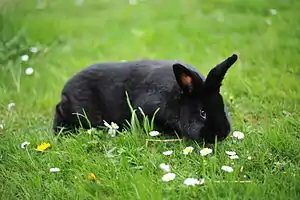 | 7–9 lb (3.2–4.1 kg) | Short | Erect | Black | No | Yes | |
| Altex | 13 lb (5.9 kg) | Short | Erect | Pointed White | No | No | ||
| American |  | 9–12 lb (4.1–5.4 kg) | Short | Erect | Blue, White | Yes | No | |
| American Chinchilla [US] See also: Chinchilla |  | 9–12 lb (4.1–5.4 kg) | Short | Erect | Chinchilla | Yes | No | |
| American Fuzzy Lop | 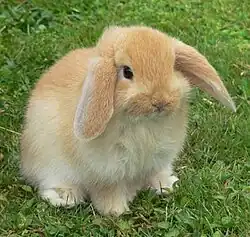 | 3.5–4 lb (1.6–1.8 kg) | Long | Lop | [All solid or broken colors/patterns] | Yes | No | |
| American Sable |  | 7–10 lb (3.2–4.5 kg) | Short | Erect | Sable | Yes | No | |
| Angora | 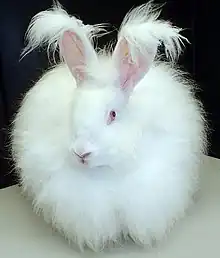 | 4.4–12.1 lb (2.0–5.5 kg) | Short | Erect | Albino or Colored | Yes | Yes | |
| Argente Bleu | Image | 6 lb (2.7 kg) | Short | Erect | [Argente Bleu markings][lower-alpha 1] | No | Yes | |
| Argente Brun [UK] | Image | 6 lb (2.7 kg) | Short | Erect | [Argente Brun [UK] markings][lower-alpha 2] | No | Yes | |
| Argente Brun [US] | Image | 8–10.5 lb (3.6–4.8 kg) | Medium | Erect | [Argente Brun [US] markings][lower-alpha 3] | Yes | No | |
| Argente Clair[7] | Image | 6 lb (2.7 kg) | Short | Erect | [Blue base heavily silvered] | No | No | |
| Argente Crème [UK] See also: Creme d'Argent [US] | Image | 5 lb (2.3 kg) | Short | Erect | [Argente Crème markings][lower-alpha 4] | No | Yes | |
| Argente de Champagne [UK] See also: Champagne d'Argent [US] | 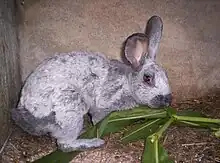 | 9–12 lb (4.1–5.4 kg) | Short | Erect | [Argente de Champagne markings][lower-alpha 5] | No | Yes | |
| Argente Noir | Image | 6 lb (2.7 kg) | Short | Erect | [Argente Noir markings][lower-alpha 6] | No | Yes | |
| Argente St Hubert | Image | 6 lb (2.7 kg) | Short | Erect | [Argente St Hubert markings][lower-alpha 7] | No | Yes | |
| Armenian Marder[1] | Image | 8.8–9.9 lb (4.0–4.5 kg) | Short | Erect | [Dark Brown or Light Brown (either having light to heavy chinchillation)] | No | No | |
| Astrex See also: Rex [US] | Image | 6–8 lb (2.7–3.6 kg) | Rex Curly Short | Erect | "Any [BRC-]recognised Rex Colour." | No | Yes | |
| Aurora Negro[1][8] |  | — | — | — | — | No | No | |
| Baladi Black[9] |  | 6.0 lb (2.7 kg) | Short | Erect | Black | No | No | |
| Baladi Red[9] | Image | 6.2 lb (2.8 kg) | Short | Erect | Red | No | No | |
| Baladi White[9] |  | 4.3 lb (1.95 kg) | Short | Erect | White | No | No | |
| Bauscat | Image | 8 lb (3.6 kg) | Short | Erect | Albino | No | No | |
| Beige [UK] See also: Czech Solver [CZ] Separator [DE] | 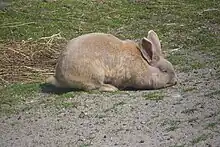 | 5–6.5 lb (2.3–2.9 kg) | Short | Erect | "Dark Chamois or light sandy colour, down to the skin, faintly ticked with blue." | No | Yes | |
| Belgian Hare [UK] | .jpg.webp) | 8–9 lb (3.6–4.1 kg) | Short | Erect | "Rich, deep chestnut red, well extended down the sides. Black ticking of a wavy or blotchy appearance, plentiful on body; chest and face free." | No | Yes | |
| Belgian Hare [US] |  | 8–9.5 lb (3.6–4.3 kg) | Short | Erect | "Deep red 'rufous' coat with black, wavy ticking." | Yes | No | |
| Beveren [UK] See also: Pointed Beveren | Image | 8 lb (3.6 kg) | Medium | Erect | Black, Blue, Brown, Lilac, White [with blue eyes] | No | Yes | |
| Beveren [US] | Image | 8–12 lb (3.6–5.4 kg) | Medium | Erect | Black, Blue, White [with blue eyes] | Yes | No | |
| Big Silver Marten[10] Also called: Große Weißgrannen [de] Veliki Bijeloopaljeni Kunić [hr] See also: Silver Marten |  | 8–12 lb (3.6–5.4 kg) | Short | Erect | [Black, Blue, or Havana with white and/or tan markings, plus white ticking on the lower body] | No | No | |
| Blanc de Bouscat |  | 11–15.5 lb (5.0–7.0 kg) | Short | Erect | "Completely snow white [...]. Guard hairs sprinkled regularly all over the coat give it a brilliant frosty look." | No | Yes | |
| Blanc de Hotot | 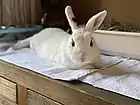 | 8–11 lb (3.6–5.0 kg) | Short | Erect | White with dark rings around the eyes | Yes | Yes | |
| Blanc de Popielno Also called: Popielański Biały [pl] Popielno White | Image | 8.8–11.0 lb (4–5 kg) | Short | Erect | Albino | No | No | |
| Blanc de Termonde | Image | 9–12 lb (4.1–5.4 kg) | Short | Erect | "Immaculately white. Eyes are ruby red" | No | Yes | |
| Blue of Ham | Image | 9.9–13.2 lb (4.5–6 kg) | Long | Erect | "Slate blue with a blue sub-color" but "not as dark as the blue Vienna" | No | No | |
| Blue of Sint-Niklaas | 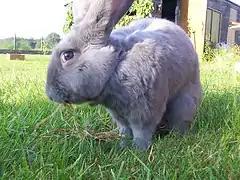 | 5–12 lb (2.3–5.4 kg) | Short | Erect | Blue | No | No | |
| Bourbonnais Grey Also called: Gris du Bourbonnais [fr] | 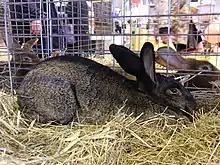 | 7–11 lb (3.2–5.0 kg) | Short | Erect | "Overall color is slate blue with longer gray guard hairs tipped black." | No | No | |
| Brazilian | Image | 7–11 lb (3.2–5.0 kg) | Short | Erect | — | No | No | |
| Britannia Petite [US] See also: Polish [UK] |  | 1.5–2.5 lb (0.68–1.13 kg) | Short | Erect | Black, Black Otter, Blue-Eyed White, Chestnut, Red-Eyed White, Sable Marten | Yes | No | |
| British Giant |  | 12.5–25 lb (5.7–11.3 kg) | Short | Erect | Black, Blue, Brown Grey, Dark Steel Grey, Opal, White | No | Yes | |
| Brown Chestnut of Lorraine Also called: Brun Marron de Lorraine [fr] | Image | 4.4–5.3 lb (2.0–2.4 kg) | Short | Erect | "Chestnut brown uniform color with a well-defined orange-brown outer-color. Under-color bluish including the belly. Ears bluish on their inner side and edged with a black border." | No | No | |
| Caldes[11] | Image | 9.5–9.9 lb (4.3–4.5 kg) | Short | Erect | Red-Eyed White | No | No | |
| Californian [UK] | 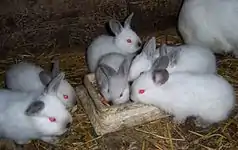 | 7.5–9.5 lb (3.4–4.3 kg) | Short | Erect | Four varieties, all being white (with red eyes) with dark points: Normal ("dark sepia" points), Chocolate ("milk chocolate" points), Blue ("slate blue" points), or Lilac ("pink shade of dove" points) | No | Yes | |
| Californian [US] | 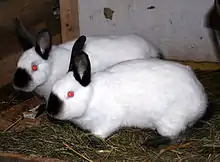 | 9–10.5 lb (4.1–4.8 kg) | Short | Erect | One variety, being white (with red eyes) with dark points: Standard (black points) | Yes | No | |
| Canadian Plush Lop See also: Rex [US] | Image | 3.5–6.5 lb (1.6–2.9 kg) | Rex Curly Medium | Lop | [Includes at least 19 stated colors/patterns] | No | No | |
| Carmagnola Grey | Image | 7.7–9.9 lb (3.5–4.5 kg) | Short | Erect | [Chinchilla] | No | No | |
| Cashmere Lop See also: Miniature Cashmere Lop |  | 4.25–5.25 lb (1.93–2.38 kg) | Long | Lop | [Includes >35 different colors/patterns][lower-alpha 8] | No | Yes | |
| Champagne d'Argent [US] See also: Argente de Champagne [UK] |  | 9–12 lb (4.1–5.4 kg) | Short | Erect | [Champagne d'Argent markings][lower-alpha 9] | Yes | No | |
| Chaudry |  | 8–9 lb (3.6–4.1 kg) | Short | Erect | Red-Eyed White | No | No | |
| Checkered Giant [US] See also: Giant Papillon [UK] |  | 11–25 lb (5.0–11.3 kg) | Short | Erect | Black (i.e, white with black markings), Blue (i.e., white with gray markings) | Yes | No | |
| Chinchilla See main entries: American Chinchilla [US] Chinchilla [UK] Chinchilla Giganta [UK] Giant Chinchilla [US] Standard Chinchilla [US] | — | — | — | — | — | — | — | — |
| Chinchilla [UK] | 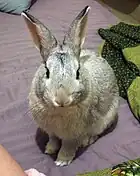 | 7 lb (3.2 kg) | Short | Erect | "To resemble real Chinchilla." | No | Yes | |
| Chinchilla Giganta [UK] | 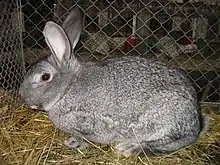 | 8.5–12 lb (3.9–5.4 kg) | Short | Erect | [Chinchilla, but with] "Desired top colour considerably darker grey than the Chinchilla [i.e., Chinchilla [UK]] rabbit." | No | Yes | |
| Cinnamon | Image | 10–11 lb (4.5–5.0 kg) | Short | Erect | Cinnamon | Yes | No | |
| Continental Giant Coloured | Image | 12.4–25 lb (5.6–11.3 kg) | Short | Erect | Agouti, Black, Chinchilla, Dark Steel, Light Steel, Opal, Red Agouti, Yellow | No | Yes | |
| Continental Giant White | Image | 11–25 lb (5.0–11.3 kg) | Short | Erect | "Immaculate white, eyes pink or blue." | No | Yes | |
| Creme d'Argent [US] See also: Argente Crème [UK] | Image | 8–11 lb (3.6–5.0 kg) | Short | Erect | "Creamy white with an orange cast" | Yes | No | |
| Criollo[12] |  | 3–4 lb (1.4–1.8 kg) | Short | Erect | "Many colors and patterns."[7] | No | No | |
| Cuban Brown[13] | 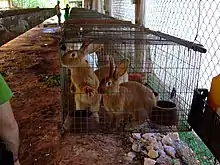 | 9.9–11.0 lb (4.5–5 kg) | Short | Erect | Glossy brown | No | No | |
| Czech Red | 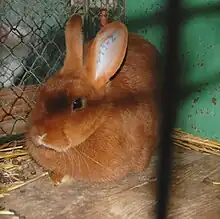 | 4–5 lb (1.8–2.3 kg) | Short | Erect | Chestnut | No | No | |
| Czech Solver [CZ][14] Also called: Český Luštič See also: Beige [UK] Separator [DE] |  | 7.9–8.6 lb (3.6–3.9 kg) | Short | Erect | [sandy colored] | No | No | |
| Czech Spot | 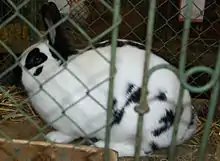 | 6–8 lb (2.7–3.6 kg) | Short | Erect | Agouti, Black, Blue, Isabella (Beige), Tortoise, Tri-color[7] | No | No | |
| Czech White[14] Also called: Český Albín | 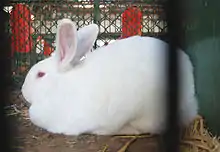 | 8.8–11.0 lb (4.0–5.0 kg) | Short | Erect | White | No | No | |
| Dalmatian |  | 6–8 lb (2.7–3.6 kg) | Rex Straight Short | Erect | White with "numerous little coloured patches" of "black, blue, brown, orange, or fawn". | No | Yes | |
| Deilenaar | 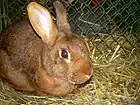 | 5–8 lb (2.3–3.6 kg) | Short | Erect | Red Agouti | No | Yes | |
| Dutch [UK] |  | 4.5–5 lb (2.0–2.3 kg) | Short | Erect | ["Dutch" markings on] Black, Blue, Brown Grey, Chocolate, Pale Grey, Steel Grey, Tortoiseshell, Yellow | No | Yes | |
| Dutch [US] | 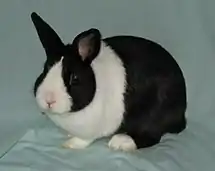 | 3.5–5.5 lb (1.6–2.5 kg) | Short | Erect | Black Dutch, Blue Dutch, Chinchilla Dutch, Chocolate Dutch, Gray Dutch, Steel Dutch, Tortoise Dutch | Yes | No | |
| Dutch (Tri-Colour) See main entry: Tri-Colour Dutch | — | — | — | — | — | — | — | — |
| Dwarf Hotot |  | 2–3 lb (0.91–1.36 kg) | Short | Erect | White with black around the eyes | Yes | No | |
| Dwarf Lop [UK] See also: Mini Lop [US] |  | 4.25–5.25 lb (1.93–2.38 kg) | Short | Lop | [Many] | No | Yes | |
| Elfin See main entry: Swedish Hare | — | — | — | — | — | — | — | — |
| Enderby Island |  | 3–4 lb (1.4–1.8 kg) | Short | Erect | "Silver-grey" (with chinchillation) or "Cream or beige" | No | No | |
| English Angora | 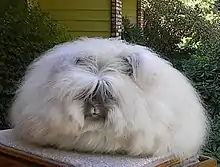 | 5–8 lb (2.3–3.6 kg) | Long | Erect | [Many] | Yes | Yes | |
| English Lop | 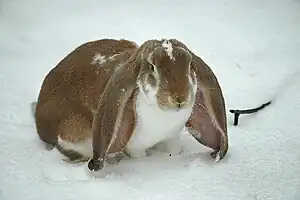 | 10–11 lb (4.5–5.0 kg) | Short | Lop | [Many] | Yes | Yes | |
| English Spot | 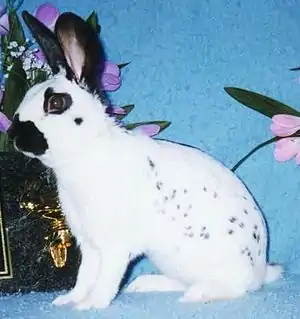 | 5–8 lb (2.3–3.6 kg) | Short | Erect | White with colored butterfly pattern | Yes | Yes | |
| Fauve de Bourgogne | 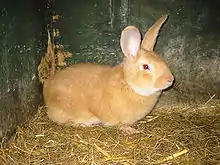 | 7–11 lb (3.2–5.0 kg) | Short | Erect | Orange/Red | No | Yes | |
| Fee[7] de Marbourg See main entry: Marburger Feh [UK] | — | — | — | — | — | — | — | — |
| Feh[7] de Marbourg [FR] See main entry: Marburger Feh [UK] | — | — | — | — | — | — | — | — |
| Feu Noir [FR] See main entry: Tan | — | — | — | — | — | — | — | — |
| Flemish Giant [UK] |  | 11–25 lb (5.0–11.3 kg) | Short | Erect | "Dark steel grey, with even or wavy ticking [...] except belly & under tail which shall be white [...]." | No | Yes | |
| Flemish Giant [US] |  | 14–25 lb (6.4–11.3 kg) | Short | Erect | Black, Blue, Fawn, Light Grey, Sandy, Steel, White | Yes | No | |
| Florida White | 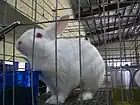 | 4–6 lb (1.8–2.7 kg) | Short | Erect | White | Yes | No | |
| Fox | Image | 6.6–11.0 lb (3–5 kg) | Long | Erect | "It is most common in the color white." | No | No | |
| Fox–Silver [UK] See also: Silver Fox [US] |  | 5.5–7 lb (2.5–3.2 kg) | Short | Erect | Black, Blue, Chocolate, Lilac | No | Yes | |
| French Angora |  | 7.5–10.5 lb (3.4–4.8 kg) | Long | Erect | [Many] | Yes | No | |
| French Lop | 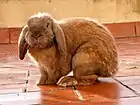 | 10 lb (4.5 kg) | Short | Lop | [Many] | Yes | Yes | |
| Gabali | Image | 6–7 lb (2.7–3.2 kg) | Short | Erect | Agouti | No | No | |
| German Angora[15] | Image | 5.5–12.1 lb (2.5–5.5 kg) | Long | Erect | [Albino or colored (but not bi-colored)] | No | No | |
| German Lop | 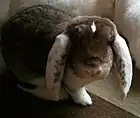 | 6–8 lb (2.7–3.6 kg) | Short | Lop | [Many] | No | Yes | |
| Giant Angora |  | 10 lb (4.5 kg) | Long | Erect | — | Yes | No | |
| Giant Chinchilla [US] See also: Chinchilla |  | 10–16 lb (4.5–7.3 kg) | Short | Erect | Chinchilla | Yes | No | |
| Giant Havana Also called: Stor Havana [da] Stora Havana [se] See also: Havana [UK] Havana [US] | Image | 10–11 lb (4.6–5 kg) | Short | Erect | "Dark brown and glossy color. The eyes are brown, but from certain points of view they are ruby red." | No | No | |
| Giant Marburger Also called: Stor Marburger Egern [da] See also: Marburger Feh [UK] | Image | 10–11 lb (4.6–5 kg) | Medium | Erect | "A grey-blue outer color with a brownish undertone." | No | No | |
| Giant Papillon [UK] See also: Checkered Giant [US] Miniature Papillon | 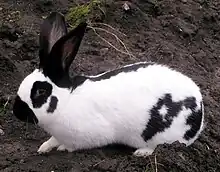 | 11–25 lb (5.0–11.3 kg) | Short | Erect | [Colored butterfly, eye circles, cheek spots, ear base, saddle, and rump spots; all on a base of white.] "All [BRC] recognised colours are admissible." | No | Yes | |
| Giant Silver Also called: Stor Sølv [da] Stora Sølv [se] See also: Silver [UK] Silver [US] | Image | 10–11 lb (4.6–5 kg) | Short | Erect | "The entire body has a black base color mixed with hair with white tips that gives the rabbit a silver sheen." | No | No | |
| Giant Smoke Pearl Also called: Stor Zobel [da] Stora Zobel [se] See also: Smoke Pearl | Image | 8.8–11.0 lb (4–5 kg) | Short | Erect | "A mixture of brown, so-called sepia-colored and beige tones" [with darker points]. | No | No | |
| Giza White[16] | Image | 5.6–7.6 lb (2.53–3.45 kg) | Short | Erect | Albino | No | No | |
| Golden Glavcot | Image | 5–6 lb (2.3–2.7 kg) | Short | Erect | — | No | Yes | |
| Gotland | 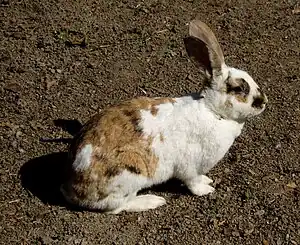 | 6.6–9 lb (3.0–4.1 kg) | Short | Erect | — | No | No | |
| Gouwenaar | Image | 5.5–7.1 lb (2.5–3.2 kg) | Short | Erect | "The body color has a light grey-blue tone throughout the body." | No | No | |
| Grey Pearl of Halle Also called: Gris Perle de Hal Lille Egern Parelgrijze van Halle | Image | 5.5–7.1 lb (2.5–3.2 kg) | Short | Erect | "The body color is a light grey-blue tone throughout the body." | No | No | |
| Güzelçamlı |  | 5–8 lb (2.3–3.6 kg) | Short | Erect | White with chocolate markings | No | No | |
| Harlequin [UK] | 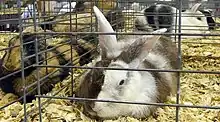 | 6–8 lb (2.7–3.6 kg) | Short | Erect | Harlequin (includes: Black, Blue, Brown, Lilac) Magpie (includes: Black, Blue, Brown, Lilac) | No | Yes | |
| Harlequin [US] |  | 6–9 lb (2.7–4.1 kg) | Short | Erect | Japanese (includes: Black, Blue, Chocolate, Lilac) Magpie (includes: Black, Blue, Chocolate, Lilac) | Yes | No | |
| Harlequin Dutch See main entry: Tri-Colour Dutch | — | — | — | — | — | — | — | — |
| Harlequin Rex Also called: Magpie Rex Japanese Rex |  | 6–8 lb (2.7–3.6 kg) | Rex Straight Short | Erect | [ Same as for Harlequin [UK] ] | No | Yes | |
| Havana [UK] See also: Giant Havana | Image | 5.5–6.5 lb (2.5–2.9 kg) | Short | Erect | "A rich, dark chocolate with a purplish sheen, [...] pearl-grey undercolour." | No | Yes | |
| Havana [US] See also: Giant Havana | 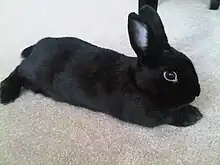 | 4.5–6.5 lb (2.0–2.9 kg) | Short | Erect | Black, Blue, Broken, Chocolate, Lilac | Yes | No | |
| Himalayan Also called: Russian | 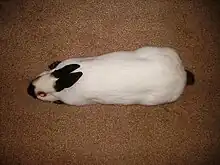 | 6–8 lb (2.7–3.6 kg) | Short | Erect | White with points of either black, blue, chocolate, or lilac | Yes | Yes | |
| Holland Lop [US] See also: Miniature Lop [UK/NL] | 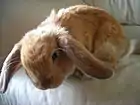 | 4–6.5 lb (1.8–2.9 kg) | Short | Lop | Agouti, Broken, Pointed White, Self Colors, Shaded Colors, Tan Pattern, Ticked, Wide Band | Yes | No | |
| Hulstlander | Image | 4–6 lb (1.8–2.7 kg) | Short | Erect | White with blue eyes | No | Yes | |
| Hungarian Giant[17] | Image | 11–15 lb (5–7 kg) | Short | Erect | [Many] | No | No | |
| Isabella | Image | 6.6–8.8 lb (3–4 kg) | Short | Erect | "The yellowish brown color is 'coated' with a blue veil, caused by blue hair tips. In front of the head there is the 'mask', which when seen from the front, is oval." | No | No | |
| Jamora | Image | 4.2–5.3 lb (1.9–2.4 kg) | Long | Erect | "[L]ike [Harlequin or] Japanese. The most common color is black / yellow, but black and white may occur." | No | No | |
| Japanese Dutch See main entry: Tri-Colour Dutch | — | — | — | — | — | — | — | — |
| Japanese White Also called: 日本白色種 [ja] Includes: ジャンボうさぎ [ja] Jumbo Usagi | 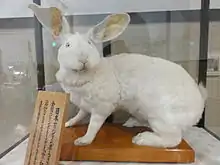 | 6.6–22.0 lb (3–10 kg) | Short | Erect | Albino | No | No | |
| Jersey Wooly |  | 2.5–3.5 lb (1.1–1.6 kg) | Long | Erect | [Many] | Yes | No | |
| Kabyle | Image | 4.4–6.6 lb (2.0–3.0 kg) | Short | Erect | [Many] | No | No | |
| Lilac [UK] | Image | 5.5–7 lb (2.5–3.2 kg) | Short | Erect | "An even pink shade of dove colour" | No | Yes | |
| Lilac [US] | Image | 5–8 lb (2.3–3.6 kg) | Short | Erect | "Pinkish dove-gray" | Yes | No | |
| Lionhead [UK] |  | 3.0–3.7 lb (1.36–1.7 kg) | Long | Erect | "All [BRC] recognised colour[s] and pattern[s]" | No | Yes | |
| Lionhead [US] | 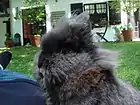 | 3.25–3.75 lb (1.47–1.70 kg) | Long | Erect | Chocolate, Ruby-Eyed White, Seal, Siamese Sable, Tortoise (includes Black, Blue, Chocolate, Lilac) | Yes | No | |
| Liptov Baldspotted Rabbit Also called: Liptovský lysko | Image | 8.8–9.4 lb (4–4.25 kg) | Short | Erect | Agouti, Blue-Agouti, or Black | No | No | |
| Lynx Also called: Luchskaninchen Lux | Image | 5.5–7.1 lb (2.5–3.2 kg) | Short | Erect | "Lux has a wild factor and the outermost part of the hair is light grey. Under this color, the middle color is reddish-brown. The middle color is so high that it shines through the entire color. The entire color therefore appears as a reddish-brown tone 'coated' with a light grey-blue cut." | No | No | |
| Marburger Feh [UK] Originally named: Fee de Marbourg Renamed: Feh de Marbourg [FR][7] See also: Giant Marburger | 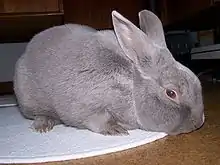 | 4.15–7.2 lb (1.88–3.27 kg) | Short | Erect | [Lilac:] "The top colour is a delicately toned light blue which appears to be covered with a brownish veil." | No | Yes | |
| Mecklenburger Piebald[18] Also called: Mecklenburger Schecke | 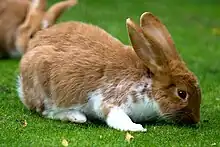 | 9.9–12.1 lb (4.5–5.5 kg) | Medium | Erect | "[Broken pattern: mostly solid color with neck, chest, belly, legs. Includes Agouti, Black, Blue, Red, Steel]" | No | No | |
| Meissner Lop |  | 10–12 lb (4.5–5.4 kg) | Short | Lop | [Many] | No | Yes | |
| Mellerud rabbit | 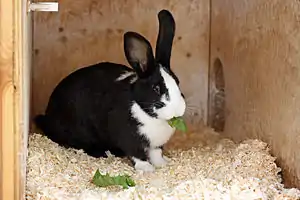 | 6.6–7.7 lb (3.0–3.5 kg) | Short | Erect | Albino, Black with inexact "Dutch" markings | No | No | |
| Mini Cashmere Lop See main entry: Miniature Cashmere Lop | — | — | — | — | — | — | — | — |
| Mini Lion Lop See main entry: Miniature Lion Lop | — | — | — | — | — | — | — | — |
| Mini Lop [US] Not to be confused with: Miniature Lop [UK/NL] |  | 5–6 lb (2.3–2.7 kg) | Short | Lop | [To be supplied] | Yes | No | |
| Mini Rex See also: Rex [US] | 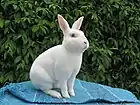 | 3–4.5 lb (1.4–2.0 kg) | Rex Straight Short | Erect | Black, Blue, Castor, Chinchilla, Chocolate, Himalayan, Lilac, Lynx, Marten, Opal, Otter, Red, Sable, Sable Point, Seal, Tortoise, Red-Eyed White, Blue-Eyed White, Broken (white with any accepted color), Tri-Color (white with one of the following four pairs: Black & Orange, Lilac & Fawn, Chocolate & Orange, Blue & Fawn), Pattern | Yes | Yes | |
| Mini Satin [US] Not to be confused with: Miniature Satin [UK] |  | 4 lb (1.8 kg) | Short | Erect | Black, Blue, Broken, Chinchilla, Chocolate, Chocolate Agouti, Copper, Himalayan (includes Black, Blue, Chocolate, Lilac), Opal, Red, Siamese (includes Blue, Chocolate, Lilac), Silver Marten (includes Black, Blue, Chocolate, Lilac), Squirrel, Tortoise, White | Yes | No | |
| Miniature Cashmere Lop See also: Cashmere Lop |  | 3.5 lb (1.6 kg) | Long | Lop | [same as Cashmere Lop] | No | Yes | |
| Miniature Lion Lop |  | 3.3–3.5 lb (1.5–1.6 kg) | Long | Lop | Chocolate Point Also: "Any [BRC] colour or pattern [...] apart from the broken pattern." | No | Yes | |
| Miniature Lop [UK/NL] Not to be confused with: Mini Lop [US] See also: Holland Lop [US] |  | 3.4–3.8 lb (1.5–1.7 kg) | Short | Lop | "Any [BRC] colour or pattern [...] apart from the broken pattern." | No | Yes | |
| Miniature Papillon Also called: Dværgschecke [da] See also: Giant Papillon [UK] | Image | 2.6–4.2 lb (1.2–1.9 kg) | Short | Erect | Black/White, Blue/White, Tri-colour (Black & Gold) [Colored butterfly, eye circles, cheek spots, ear base, saddle, side-body patches, and top of tail; all on a base of white] | No | Yes | |
| Miniature Satin [UK] Not to be confused with: Mini Satin [US] |  | 4–5 lb (1.8–2.3 kg) | Short | Erect | Ivory | No | Yes | |
| Moshtohor[1] Also called: Line M | Image | 5.3–8.6 lb (2.40–3.91 kg) | Short | Erect | Yellowish-Brown, White, or Grey | No | No | |
| Netherland Dwarf | 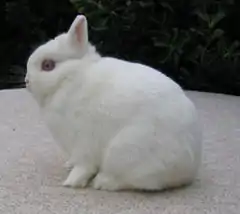 | 1.1–2.5 lb (0.50–1.13 kg) | Short | Erect | [Many] | Yes | Yes | |
| New Zealand [US] | 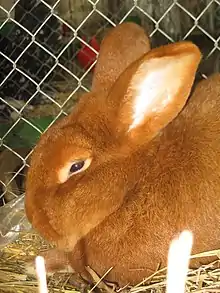 | 9–12 lb (4.1–5.4 kg) | Short | Erect | Black, Blue, Broken, Red, White | Yes | No | |
| New Zealand red [UK] | 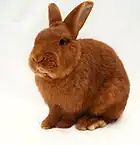 | 8 lb (3.6 kg) | Short | Erect | "Bright golden red or reddish gold with sheen" | No | Yes | |
| New Zealand white [UK] | 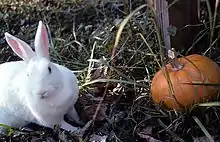 | 9–12 lb (4.1–5.4 kg) | Short | Erect | Black, Blue, White | No | Yes | |
| Nitransky[1] | Image | 7.7–12.1 lb (3.5–5.5 kg) | Short | Erect | [White with diluted "Californian" markings] | No | No | |
| Opossum See also: Rex [US] | Image | 6–8 lb (2.7–3.6 kg) | Rex Curly Long | Erect | "Any [BRC-]recognised colour." | No | Yes | |
| Orange[19] | Image | 5.5–7.1 lb (2.5–3.2 kg) | Short | Erect | " A strong and warm yellow-red outer color." | No | No | |
| Orylag[20][21] Also called: Rex du Poitou | Image | 5.5 lb (2.5 kg) | Rex Straight Short | Erect | [Many] | No | No | |
| Ørestad | Image | 5.5–7.1 lb (2.5–3.2 kg) | Short | Erect | Ruby-Eyed White | No | No | |
| Palomino | 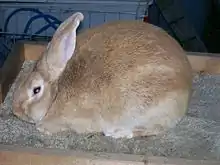 | 10–11 lb (4.5–5.0 kg) | Short | Erect | Golden, Lynx | Yes | No | |
| Pannon White | Image | 5–10 lb (2.3–4.5 kg) | Short | Erect | White | No | No | |
| Perlfee | Image | 5–8 lb (2.3–3.6 kg) | Short | Erect | "Blue Agouti" | No | Yes | |
| Plush Lop (Miniature) See also: Rex [US] | 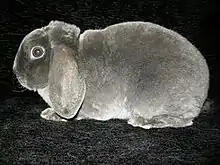 | 3.7–4.0 lb (1.7–1.8 kg) | Rex Straight Short | Lop | "Any colour and pattern accepted by the [BRC] apart from the broken pattern." | No | No | |
| Plush Lop (Standard) See also: Rex [US] | Image | 5.1–5.7 lb (2.3–2.6 kg) | Rex Straight Short | Lop | "Any colour and pattern accepted by the [BRC] apart from the broken pattern." | No | No | |
| Pointed Beveren See also: Beveren | 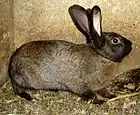 | 7 lb (3.2 kg) | Short | Erect | Black, Blue, Brown, Lilac | No | Yes | |
| Polish [UK] See also: Britannia Petite [US] |  | 2.5 lb (1.1 kg) | Short | Erect | [Includes >25 different colors/patterns][lower-alpha 10] | No | Yes | |
| Polish [US] |  | 2.5–3.5 lb (1.1–1.6 kg) | Short | Erect | Black, Blue, Blue-Eyed White, Broken, Chocolate, Red-Eyed White | Yes | No | |
| Rex [US] Originally called: Castorrex Sometimes called: Standard Rex NOTE: To see all breeds with rex fur, sort on the "Fur Type" column. |  | 6–10.5 lb (2.7–4.8 kg) | Rex Straight Short | Erect | [Over 19 stated colors/patterns][lower-alpha 11] | Yes | No | |
| Rex du Poitou See main entry: Orylag | — | — | — | — | — | — | — | — |
| Rhinelander See also: Rhinsk Schecke [da][22] |  | 9–10 lb (4.1–4.5 kg) | Short | Erect | White with coloured butterfly patterns | Yes | Yes | |
| Rhone Also called: Rhön | Image | 5.5–7.1 lb (2.5–3.2 kg) | Short | Erect | "A white/black rabbit whose color/pattern is intended to resemble the surface of a birch tree." | No | No | |
| Russian See main entry: Himalayan | — | — | — | — | — | — | — | — |
| SA Phendula | 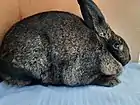 | 8.8–11.5 lb (4.0–5.2 kg) | Short | Erect | Chestnut Agouti, Gold or Silver Tipped Steel, Black | No | No | |
| Sachsengold Also called: Saxon Gold[23] | 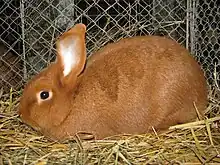 | 6.1–7.2 lb (2.75–3.25 kg) | Short | Erect | Chestnut | No | No | |
| Sallander | Image | 5–9 lb (2.3–4.1 kg) | Short | Erect | — | No | Yes | |
| San Juan | Image | 3–5 lb (1.4–2.3 kg) | Short | Erect | Agouti | No | No | |
| Satin [UK] See also: Miniature Satin [UK] | 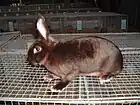 | 6–8 lb (2.7–3.6 kg) | Medium | Erect | [Includes >33 different colors/patterns][lower-alpha 12] | No | Yes | |
| Satin [US] See also: Mini Satin [US] |  | 9.5–10 lb (4.3–4.5 kg) | Short | Erect | Black, Blue, Broken, Californian, Chinchilla, Chocolate, Copper, Lilac(under development), Otter, Red, Siamese, White | Yes | No | |
| Satin Angora | 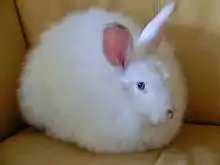 | 6.5–9.5 lb (2.9–4.3 kg) | Long | Erect | [White or Colored] | Yes | No | |
| Schwarzgrannen [UK] | Image | 4.41–7.17 lb (2.00–3.25 kg) | Short | Erect | "[P]ure white [with] black ticking" | No | Yes | |
| Separator [DE] See also: Beige [UK] Czech Solver [CZ] |  | 6.6–8.3 lb (3–3.75 kg) | Short | Erect | [sandy colored] | No | No | |
| Siamese Sable |  | 5–7 lb (2.3–3.2 kg) | Short | Erect | Light Siamese Sable, Medium Siamese Sable, Dark Siamese Sable | No | Yes | |
| Siberian | Image | 5–7 lb (2.3–3.2 kg) | Short | Erect | Black, Blue, Brown, Lilac | No | Yes | |
| Silver [UK] See also: Giant Silver |  | 5–6 lb (2.3–2.7 kg) | Short | Erect | Blue, Brown, Fawn, Grey | No | Yes | |
| Silver [US] See also: Giant Silver |  | 4–7 lb (1.8–3.2 kg) | Short | Erect | Black, Brown, Fawn | Yes | No | |
| Silver Fox [UK] See main entry: Fox–Silver [UK] | — | — | — | — | — | — | — | — |
| Silver Fox [US] | 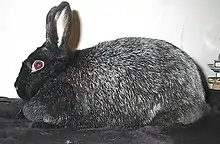 | 9–12 lb (4.1–5.4 kg) | Long | Erect | Black, Blue(under development), Chocolate(under development) | Yes | No | |
| Silver Marten Also called: Beloresavec [sl] Weißgrannen [de] See also: Big Silver Marten | 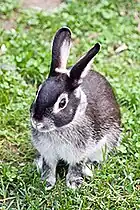 | 9.5 lb (4.3 kg) | Short | Erect | Black, Blue, Chocolate, Sable | Yes | No | |
| Simenwar[24] |  | 2.95 lb (1.337 kg) | — | — | — | No | No | |
| Slovenian Rabbit[1] Also called: Slovenski kunec [si] | Image | 6.6–11.0 lb (3–5 kg) | Short | Erect | "Blue velvet" with "yellowish-brown" substrate and flecking. [Similar to the "St Hubert" hairshaft?] "The tail and belly are white, and the eyes are brown." | No | No | |
| Smoke Pearl Also called: Sinisoopeli [fi] Zobel blå [sv][25] Zobel blue [da] See also: Giant Smoke Pearl | Image | 5–7 lb (2.3–3.2 kg) | Short | Erect | Marten type ["smoke in colour, shading to pearl grey beige" with certain white touches, including eye circles] or Siamese type [same but with no white touches] | No | Yes | |
| Spanish Giant | Image | 12.5–15 lb (5.7–6.8 kg) | Short | Erect | — | No | No | |
| Squirrel | Image | 5–7 lb (2.3–3.2 kg) | Short | Erect | — | No | Yes | |
| Standard Chinchilla [US] See also: Chinchilla |  | 5–7.5 lb (2.3–3.4 kg) | Short | Erect | Chinchilla | Yes | No | |
| Standard Rex See main entry: Rex [US] | — | — | — | — | — | — | — | — |
| Stone rabbit Also called: Steenkonijn[26] [nl] | Image | 6.1 lb (2.75 kg) | Short | Erect | Haaskleur ("hare" = red agouti), Konijngrijs ("rabbit grey" = grey agouti), Ijzergrauw ("iron grey" = steel agouti) | No | No | |
| Sussex | Image | 7–8 lb (3.2–3.6 kg) | Short | Erect | [Shaded] Cream, [Shaded] Gold | No | Yes | |
| Swedish Fur Also called: Svensk Pels | Image | 6.6–8.2 lb (3–3.7 kg) | Short | Erect | "Glossy black with evenly spaced white hair." | No | No | |
| Swedish Hare Includes the breed prev. named: Elfin | 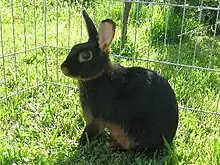 | 5 lb (2.3 kg) | Short | Erect | All colors and markings are acceptable | No | No | |
| Swiss Fox |  | 5–8 lb (2.3–3.6 kg) | Long | Erect | — | No | Yes | |
| Tadla | Image | 4–5 lb (1.8–2.3 kg) | Short | Erect | Agouti | No | No | |
| Tan Also called: Feu Noir [FR] | 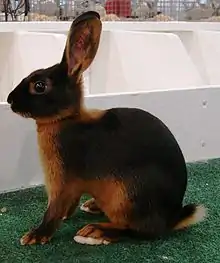 | 4–6 lb (1.8–2.7 kg) | Short | Erect | Black & Tan, Blue & Tan, Chocolate & Tan, Lilac & Tan | Yes | Yes | |
| Tax-Xiber | Malta[27][28] | |||||||
| Teddy Dwarf Also called: Teddyzwerg [DE] |  | 1.8–3.7 lb (0.8–1.7 kg) | Long | Erect | [Many] | No | No | |
| Teddy Lop Also called: Teddywidder [DE] | 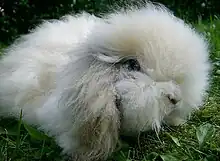 | 2.9–4.4 lb (1.3–2.0 kg) | Long | Lop | [Many] | No | No | |
| Thrianta | 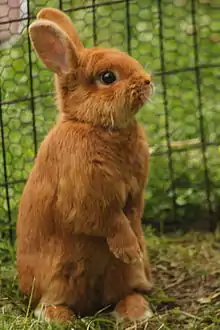 | 6 lb (2.7 kg) | Short | Erect | Chestnut | Yes | Yes | |
| Thuringer Also called: Thüringer |  | 9 lb (4.1 kg) | Short | Erect | [Sable with dark points] | No | Yes | |
| Tri-Colour Dutch Also called: Harlequin Dutch Japanese Dutch |  | 4–5 lb (1.8–2.3 kg) | Short | Erect | [Tri-Colour Dutch markings][lower-alpha 13] | No | Yes | |
| Tri-Colour English | 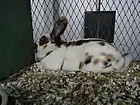 | 6–8 lb (2.7–3.6 kg) | Short | Erect | [Tri-Colour English markings][lower-alpha 14] | No | Yes | |
| Trønder | Image | 8.8–13.2 lb (4–6 kg) | Short | Erect | "The color is shiny black with evenly distributed white hair. The white hairs are white in their full length" | No | No | |
| V-line[1] Also called: Line V |  | 7.3 lb (3.32 kg)[29] | — | — | — | No | No | |
| Velveteen Lop See also: Rex [US] | Image | 5–6.5 lb (2.3–2.9 kg) | Rex Straight Short | Lop | [Includes "all patterns and colors of the English Lop breed"][7] | No | No | |
| Vienna Coloured | 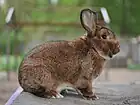 | 7.7–11.6 lb (3.5–5.25 kg) | Medium | Erect | Agouti, Black, Blue | No | Yes | |
| Vienna White |  | 7.7–11.6 lb (3.5–5.25 kg) | Short | Erect | "[P]ure white [...] very lustrous" | No | Yes | |
| Wheaten | Image | 5.5–7 lb (2.5–3.2 kg) | Short | Erect | "Wheaten (the fawn or pale yellow colour of wheat)" | No | Yes | |
| Wheaten Lynx | Image | 5.5–7 lb (2.5–3.2 kg) | Short | Erect | "Orange-shot-silver" | No | Yes | |
| White Country Also called: Hvid Land [da][30] Hvit Land [no] Vit Lant [se][31] | 8.4–10.1 lb (3.8–4.6 kg) | Short | Erect | Albino | No | No | ||
| Zemmouri[32] | Image | 4.0–6.4 lb (1.8–2.9 kg) | Short | Erect | [Black with "Dutch" markings] | No | No | |
| Zika | Image | 7.1 lb (3.2 kg) | Short | Erect | Albino | No | No |

Scope
The table of modern-day rabbit breeds includes those that are:
- recognized as a distinct breed by ARBA, the BRC, or another country's established organization for the national promotion of rabbit breeds,
- recognized as "in development" for potential formal recognition (as judged by multiple authoritative sources), or
- recognized as a distinct breed that resulted from natural selection (as judged by pertinent authoritative sources).
Rare breeds[lower-roman 1] are denoted with pink highlighting.
Terminology
Confusion sometimes arises regarding the name of a rabbit breed versus the name of a rabbit's color/pattern (or fur type). For example, Harlequin is the name of a breed whose color/pattern is known as harlequin. (This usage may have arisen from the Harlequin character, who, like this rabbit, always wears a motley-colored check-patterned coat—and suggests that the rabbit may be equally impish.) The harlequin color/pattern is found now in a different breed of rabbit: the Tri-Colour Dutch, also known as the Harlequin Dutch. Such evolutions in terminology pertain also to some fur types, where (for example) the Rex breed has rex fur. There are now other rabbit breeds that also have rex fur. For example, the unusually "rexed" Astrex rabbit breed.
It is sometimes difficult to ascertain which came first, the breed name or the color/pattern name (or fur-type name). What is certain is that in such situations the two at some point were synonymous but subsequent developments in other breeds (likely hinging on similar genetic changes) have caused the terms to diverge.
The definition of a distinct breed relies on clusters of complex individual gene-sets—clusters that may include the gene-set for a body type, the gene-set for an ear type, the gene-set for a color/pattern, and/or the gene-set for a fur type. The determination of when a group of rabbits is considered to have become a new breed (as a result of overarching genetic distinction) is left, in the following table, to the authority of ARBA, the BRC, or other reputable source.
Extinct rabbit breeds
| Breed name [lower-roman 2] |
Image [lower-roman 3] |
Size [lower-roman 4] |
Fur type [lower-roman 5] |
Ear type [lower-roman 6] |
Colors & markings [lower-roman 7] |
Origin [lower-roman 10] |
Ancestor of the modern[lower-roman 11] |
|---|---|---|---|---|---|---|---|
| Beaver | — | — | — | — | Silky & luxurious coat | — | — |
| Blanc de Chauny | — | — | — | — | Snow white | — | — |
| Blanc de L'Oural | — | 8–10 lb (3.6–4.5 kg) | — | — | Albino | — | |
| Golden Fawn | — | — | — | — | — | — | New Zealand red |
| Old English Red | — | — | — | — | — | — | |
| Patagonian | — | — | — | — | — | Flemish Giant | |
| Petite Brabancon | — | — | — | — | — | Dutch | |
| Rouennais | — | 8–10 lb (3.6–4.5 kg) | Short | Erect | — | French Lop | |
| Sitka | — | — | Long | — | — | — | |
| Swan | — | 16–20 lb (7.3–9.1 kg) | — | — | Brown, Grey | — | |
Explanatory footnotes
- 1 2 Rare here denotes a breed currently included in the BRC's "Rare Varieties Club"[6] or (because ARBA does not designate rarity) The Livestock Conservancy's "Conservation Priority List".[33] For breeds not recognized by either ARBA or the BRC, the designation of rarity is left to the conclusion of the cited authority.
- 1 2 Breed name here is the name—and in the form of the name—that is recognized by the authority of record. Other well-known forms of the breed name may be secondarily included. When different countries use a different name for the same breed of rabbit, that is noted.
- 1 2 Image strives to display a specimen of the breed that depicts its distinguishing attributes.
- 1 2 Size listed here is the range of allowed weights or is a single measurement representing either the ideal weight or the average weight. Sizes refer to that of adult animals. All measurements listed come from the breed standard or other authoritative source.
- 1 2 Fur type is here categorized as Short, Medium, Long, Rex–Straight–Short, Rex–Curly–Short, Rex–Curly–Medium or Rex–Curly–Long.
- 1 2 Ear type is here categorized as either Erect or Lop.
- 1 2 Colors & markings listed here include (verbatim) those currently recognized by ARBA or the BRC, or as described by the cited authority (in which case they are surrounded by quotation marks). Information in [square brackets] is a summary of the source material. Unless otherwise indicated, the color is a "self" color.
- ↑ ARBA recognized? is listed as Yes or No indicating whether the breed is currently recognized by the American Rabbit Breeders Association, according to the ARBA website[3] or their Standard of Perfection 2016-2020.[4]
- ↑ BRC recognized? is listed as Yes or No indicating whether the breed is currently recognized by the British Rabbit Council, according to the BRC website[5] or their Breed Standards 2016-2020.[6]
- 1 2 Origin listed here is the country or geographic area in which the breed was first considered to have become distinct. The information in this column comes almost exclusively from the work of rabbit-breed historian Bob D. Whitman[7]
- ↑ Ancestor of the modern includes notable modern-day breeds that were developed, in part, from the extinct breed.
Citation footnotes
- ↑ For the Argente Bleu, the BRC states: "Undercolour lavender blue, body colour bluish white, [...] interspersed with longer dark blue hairs to give a distinct bluish effect."
- ↑ For the Argente Brun [UK], the BRC states: "Undercolour as deep brown as possible, body colour brownish-white, the whole evenly and moderately interspersed with longer dark brown hairs to give a distinct brownish effect when viewed from a distance."
- ↑ For the Argente Brun [US], ARBA states: "Surface color is to be an even silvered or frosted chocolate brown throughout. While evenness is stressed, slightly darker muzzle butterfly, ears and feet are desirable. Longer, dark brown guard hairs are to be evenly interspersed over the entire pelt. The under color is to be a rich chocolate ideally carried right to the skin."
- ↑ For the Argente Crème, the BRC states: "Undercolour orange [...] body colour creamy white [...] interspersed with longer orange hairs to give a distinctly creamy effect."
- ↑ For the Argente de Champagne, the BRC states: "The main body to be bluish white in the adult, interspersed with longer jet black guard hairs to bring out the shade termed Old Silver [italics added] when viewed from a distance. The ears, nose and muzzle may be a slightly darker shade. The belly and underside of the tail more matt[e]. Undercolour to be dark slate blue extended down to the base of the hair shaft. A blackish delimitation band immediately under the top colour is permissible."
- ↑ For the Argente Noir, the BRC states: "Undercolour deep slate blue, body colour greyish white,[...] interspersed with longer black hairs to give a distinct 'old silver' effect."
- ↑ For the Argente St Hubert, the BRC states: "Under colour to be dark blue at the base with rich orange intermediate band together with a very narrow chestnut top band. [...] Body colour to be a creamy white [...] interspersed with jet black guard hairs to give a creamy chestnut shade."
- ↑ For the Cashmere Lop, the BRC recognizes five groups of colors/patterns: Self Colours (includes Black, Blue, Blue-Eyed White, Chocolate, Lilac, Red-Eyed White), Agouti Patterns (includes Agouti, Chinchilla, Cinnamon, Lynx, Opal, Squirrel), Shaded Colours (includes Beige, Bluepoint, Chocolate Torte, Iron Grey, Sable, Sealpoint, Siamese, Siamese Smoke, Sooty Fawn), Tan Patterns (includes Fox-Black, Fox-Blue, Fox-Chocolate, Fox-Lilac, Otter-Black, Otter-Blue, Otter-Chocolate, Otter-Lilac, Marten Sable, Marten Smoke), Other Colours (includes Butterfly, Fawn, Orange, Steel), and "Any other [BRC] colour [...] excluding Broken Pattern."
- ↑ For the Champagne d'Argent, ARBA states: "[...] the surface color should be as near the color of skimmed milk, old silver, or light ultramarine (meaning washed out blue) as is possible. Fur over entire body should carry a liberal sprinkling of longer black guard hairs."
- ↑ For the Polish [UK], the BRC recognizes seven groups of colors/patterns: Self Colours (includes Black, Blue, Brown, Lilac, White), Shaded Self Colours (includes Sable Siamese, Smoke Pearl Siamese), Agouti Patterns (includes Agouti, Chinchilla, Cinnamon, Lynx, Opal, Red Agouti, Squirrel), Tan Patterns (includes Tans, Foxes, Otter, Sable Marten, Smoke Pearl Marten), Marked (includes Himalayan), Other Colours (includes Fawn, Orange, Steel, Tortoiseshell [or Sooty Fawn]), and Any Other Variety ("To follow normal pattern.").
- ↑ For the Rex [US], ARBA recognizes the following colors: Amber, Black, Blue, Broken (includes all dual colors [any plus white], plus four tri-colors the following pair plus white]: Black & Golden Orange, Lavender Blue & Golden Fawn, dark Chocolate Brown & Golden Orange, Dove Gray & Golden Fawn), Californian, Castor, Chinchilla, Chocolate, Lilac, Lynx, Opal, Otter (includes Black Otter, Blue Otter, Chocolate Otter, Lilac Otter), Red, Sable, Seal, White.
- ↑ For the Satin [UK], the BRC recognizes: Argente d'Champagne, Argente Bleu, Argente Brun, Argente Crème, Beige, Black, Blue, Bronze, Brown, Castor, Chinchilla, Cinnamon, Fawn, Fox–Black, Fox–Blue, Fox–Chocolate, Fox–Lilac, Havana, Himalayan, Himalayan–Blue, Himalayan–Rex, Ivory, Lilac, Lynx, Opal, Orange, Sable (Marten), Sable (Siamese), Seal Pointed, Smoke Pearl (Marten), Smoke Pearl (Siamese), Sooty Fawn, Squirrel, [and any other BRC colour or pattern].
- ↑ For the Tri-Colour Dutch, the BRC states: "Ideally one cheek to be orange -the other cheek black with ears black on orange side and orange on black cheek side. Blaze is white. It commences as a point starting from near the ear roots and gradually widens evenly passing between the eyes on to the neck and nape. This white must be as wide as possible. Must not pass between the ears. The saddle must make a true ring around the body and be placed 2-3 cm (3⁄4-11⁄4in) behind the front feet. The coloured half must be 2-3 cm (3⁄4-11⁄4in) banded as regularly as possible with alternating bands of black and orange. Stops an evenly cut pair, clearing the toes, and finishing no more than halfway along the foot."
- ↑ For the Tri-Colour English, the BRC states (in part): "Marking/Pattern to be a mixture of Black and Orange or Blue and Yellow [either combination: with White]. Each part of the marking/pattern to be bi-coloured, with the exception of the cheek spots which may be single coloured. Perfect Butterfly Smut. Circle around eyes. Cheek spots to be clear from eye circles. Unbroken Saddle, to be herring-boned and clear in any distinct colour, from base of ears to tip of tail. Body or loin markings to be broken up and not to catch the saddle. Chain markings, to be as even as possible on each side. Leg markings, one distinct spot on each leg. Ideal - The markings on both sides of the rabbit to be equally balanced. Chain markings, to commence at the base of the ears in small spots, increasing in size towards the loins."
See also
- "Alba", a genetically modified "glowing" rabbit
- Animal coloration, reasons and mechanisms
- Brachycephalic, mesaticephalic, and dolichocephalic rabbit breeds
- Disruptive selection, a form of natural selection (with a rabbit example)
- Dwarf rabbit, regarding the smallest rabbit breeds
- Fur attributes in rabbits
- Genetics–Linkage maps in the domestic rabbit
- Genetics–Color genes in the domestic rabbit
- Lop rabbit, regarding ear carriage in rabbits
- Point coloration in rabbit breeds
References
- 1 2 3 4 5 6 7 "Data export: Global Rabbit Breeds by Country". DAD-IS (Domestic Animal Diversity Information System). FAO (Food and Agriculture Organization of the United Nations). 21 November 2017. Retrieved 30 March 2018.
- ↑ Szychulda, Cathy; ARBA Standards Chair. "ARBA Standards Committee". American Rabbit Breeders Association, Inc. Retrieved 20 January 2018.
- ↑ "Official ARBA website". American Rabbit Breeders Association. Retrieved 11 February 2018.
- ↑ Standard of Perfection 2016-2020. American Rabbit Breeders Association. 2015. ASIN B018GVBJK4.
- ↑ "Official BRC website". The British Rabbit Council. Archived from the original on 25 October 2005. Retrieved 11 February 2018.
- 1 2 "Breed Standards 2016-2020" (PDF). British Rabbit Council. Retrieved 29 January 2018.
- 1 2 3 4 5 6 7 8 Whitman, Bob D. (October 2004). Domestic Rabbits & Their Histories: Breeds of the World. Leawood KS: Leathers Publishing. ISBN 978-1585972753.
- ↑ Castillo, Oscar Emilio; et al. (2004). "Informe Sobre La Situación de los Recursos Zoogenéticos de Guatemala [Report on the Status of Animal Genetic Resources of Guatemala]" (PDF). Recursos Zoogenéticos de Guatemala [Zoogenetic Resources of Guatemala] (in Spanish). Ministerio de Agricultura, Ganadería y Alimentación [Ministry of Agriculture, Livestock and Food]: 1–54. Retrieved 30 March 2017.
- 1 2 3 Galal, E.S.E.; Khalil, M.H. (1994). Written at First International Conference on Rabbit Production in Hot Climates (6-8 September 1994). Baselga, M.; Marai, I.F.M. (eds.). "Development of Rabbit Industry in Egypt". Rabbit Production in Hot Climates. Cahiers Options Méditerranéennes [Mediterranean Options Papers]. Cairo (Egypt): CIHEAM – Centre International de Hautes Etudes Agronomiques Méditerranéennes [International Center for Advanced Mediterranean Agronomic Studies]. 8: 43–55. Retrieved 30 March 2018.
{{cite journal}}: CS1 maint: location (link) - ↑ Đuričić, Dražen; et al. (2011). "Mortalität vor Absetzen bei der kroatischen autochthonen Kaninchenrasse, große Weißgrannen" [Pre-weaning mortality in a croatian autochthonous breed of rabbits, Big Silver Marten] (paper article). Tierärztliche Umschau [Veterinary Survey] (in German). 66 (3): 121–124. Retrieved 27 January 2018.
- ↑ Gómez, E.A.; Rafael, O.; Ramón, J. (2002). Khalil, M.H.; Baselga, M. (eds.). "The Caldes Strain (Spain)" (PDF). Rabbit Genetic Resources in Mediterranean Countries. Options Méditerranéennes : Série B. Etudes et Recherches [Mediterranean Options: Series B. Studies and Research]. Zaragoza (Spain): CIHEAM – Centre International de Hautes Etudes Agronomiques Méditerranéennes [International Center for Advanced Mediterranean Agronomic Studies]. 38: 193–198. Retrieved 16 February 2018.
- ↑ Peace Corps (1985). "Guidelines and References: Livestock Training Component (Small Animal Husbandry)". New Zealand Digital Library. The University of Waikato. Retrieved 16 February 2018.
- ↑ "Cuban Brown Rabbit - Conejo pardo cubano". Slow Food Foundation for Biodiversity. Retrieved 16 February 2018.
- 1 2 Tůmová, E.; Martinec, M.; Chodová, D. (2011). "Analysis of Czech Rabbit Genetic Resources". Scientia Agriculturae Bohemica. 42 (3): 113–118.
- ↑ "Breed Standard: Standard of the German Angora". International Association of German Angora Rabbit Breeders (IAGARB). 3 August 2010. Retrieved 20 February 2018.
- ↑ Khalil, M.H. (2002). Khalil, M.H.; Baselga, M. (eds.). "The Giza White Rabbits (Egypt)" (PDF). Rabbit Genetic Resources in Mediterranean Countries. Options Méditerranéennes : Série B. Etudes et Recherches [Mediterranean Options: Series B. Studies and Research]. Zaragoza (Spain): CIHEAM – Centre International de Hautes Etudes Agronomiques Méditerranéennes [International Center for Advanced Mediterranean Agronomic Studies]. 38: 27–36. Retrieved 5 March 2018.
- ↑ "Hungarian Giant Rabbit". Research Centre for Farm Animal Gene Conservation. Hungarian Government - Ministry of Agriculture. Retrieved 5 March 2018.
- ↑ "Rassestandard (Breed Standard)". Hanover Mecklenburger Schecken-Club. Retrieved 2 March 2018.
- ↑ "Orange". Danmarks Kaninavlerforening ("Denmark's Rabbit Association"). Retrieved 3 March 2018.
- ↑ "Éthique exigée.("Ethics required")". éleveurs Orylag ("Orylag breeders") (in French, English, and Italian). Retrieved 1 May 2018.
- ↑ "Encyclopedia of Furs: Orylag". eFurMedia. 2010. Retrieved 1 May 2018.
Orylag, developed in France by the National Institute for Agronomic Research (INRA), is the product of 15 years of scientific research. It is the trade name for a fantastic new breed of rabbit, created by natural genetic mutation.
- ↑ "Rhinsk Schecke". Danmarks kaninavlerforening ("Denmark's Rabbit Association") (in Danish). 23 May 2016. Retrieved 3 March 2018.
- ↑ Whitman, Bob. "History of the Thrianta". American Thrianta Breeders Association. Retrieved 26 February 2018.
- ↑ Abdel-Azeem, A.S.; Abdel-Azim, A.M.; Darwish, A.A.; Omar, E.M.; Poultry Department, Faculty of Agriculture, Fayoum University, Egypt (2007). Written at Fifth International Conference on Rabbit Production in Hot Climates (2007). "Body Weight and Carcass Traits in Four Pure Breeds of Rabbits and their Crosses under Egyptian Environmental Conditions" (PDF). Hurghada (Egypt): 67–80. Retrieved 30 March 2018.
{{cite journal}}: Cite journal requires|journal=(help)CS1 maint: location (link) CS1 maint: multiple names: authors list (link) - ↑ "Zobel blå". Kaninfarg ("Rabbit color") (in Swedish). 1 March 2015. Retrieved 3 March 2018.
- ↑ "Steenkonijn ("Stone rabbit")". Steunpunt Levend Erfgoed ("Support Center for Living Heritage") (in Dutch). Retrieved 21 March 2018.
- ↑ Cassar, C. Fenkata: An emblem of Maltese peasant resistance?] quoted in Gauci-Maistre, J. Tax-xiber: the indigenous rabbit of Malta
- ↑ "Gauci-Maistre, J. Tax-xiber: the indigenous rabbit of Malta" (PDF). Retrieved 26 August 2012.
- ↑ Hassan El-Gindy, Yassmine Moemen (April 2012). "Effect of pomegranate peels (Punica granatum) supplementation as a natural anti-oxidant on the production performance, reproduction and immune response of rabbits". A Thesis Presented to the Graduate School Faculty of Agriculture (Saba Bash), Alexandria University in Partial Fulfillment of the Requirements for the Degree of Doctor of Philosophy in Animal Production. Alexandria (Egypt): 1–95. Retrieved 30 March 2018.
- ↑ Administrator (23 May 2016). "Projekt Hvid Land ("Project White Country")". Danmarks kaninavlerforening ("Denmark's Rabbit Association") (in Danish). Retrieved 3 March 2018.
- ↑ Snaula Storm, Sanna (2015). "Sveriges Kaninavelsföreningars Riksförbund (Swedish National Association of Rabbit Breeders)". SKAF (in Swedish). Retrieved 3 March 2018.
- ↑ Barkok, A.; Jaouzi, T. (2002). Khalil, M.H.; Baselga, M. (eds.). "The Zemmouri Rabbits (Morocco)" (PDF). Rabbit Genetic Resources in Mediterranean Countries. Options Méditerranéennes : Série B. Etudes et Recherches [Mediterranean Options: Series B. Studies and Research]. Zaragoza (Spain): CIHEAM – Centre International de Hautes Etudes Agronomiques Méditerranéennes [International Center for Advanced Mediterranean Agronomic Studies]. 38: 179–185. Retrieved 16 February 2018.
- ↑ "Conservation Priority List". The Livestock Conservancy. Retrieved 9 February 2018.
Further reading
- The Official Guide Book Raising Better Rabbits and Cavies, from the American Rabbit Breeders Association, Inc.
- Rabbitlopaedia - A complete guide to Rabbit Care, by Meg Brown & Virginia Richardson, Ringpress
External links
- American Rabbit Breeders Association (ARBA) (Includes links to national rabbit breed clubs in the US)
- British Rabbit Council (BRC) (Includes links to national rabbit breed clubs in the UK)
- Online Rabbit Care—Rabbit Breeds (Lists over 150 rabbit varieties)
- RabbitPedia.com—Rabbit Breeds (Information about 60+ Pet Rabbit Breeds from A to Z)
- Petadvices.com—Domestic Rabbit Breeds (Information about Domestic Rabbit Animal Breeds)
- Complete Guide of Rabbit Breeds - List of rabbit breeds approved by American Rabbit Breeders Association
- RabbitBreeders.us—Rabbit Breeds (Includes body-type and fur-type classifications for over 45 ARBA-recognized rabbit breeds)
- Raising-Rabbits—Rabbit Breeds (Lists over 170—and provides information on over 50—"global domestic" rabbit breeds)